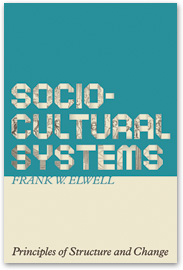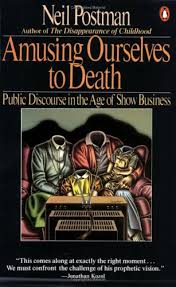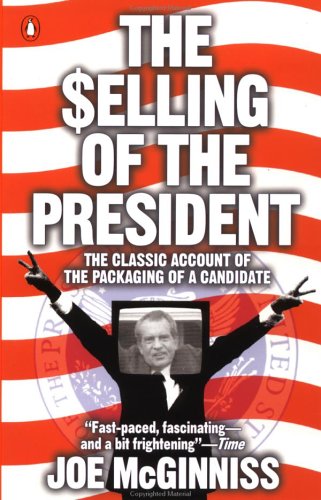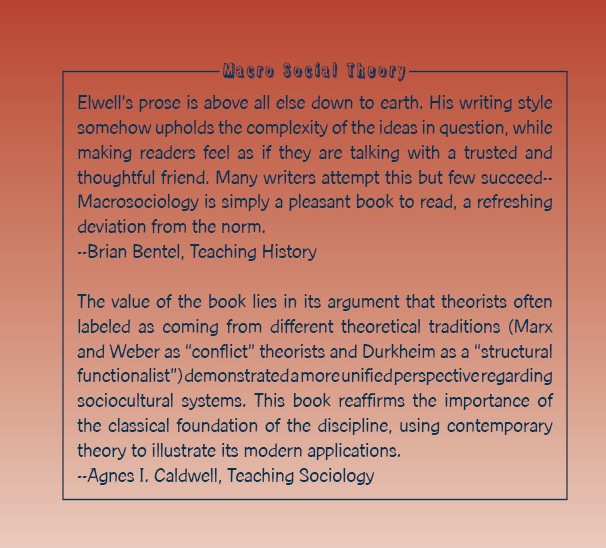
Sociocultural Systems: Principles of Structure and Change Macrosociology: Four Modern Theorists A Commentary on Malthus" 1798 Essay as Social Theory Great Classical Social Theorists In the Classical Tradition: Modern Social Theorists Dr. Elwell's Professional Page
|
rbert Spencer's Evolutionary
Sociology Neil Postman [1931-2003] | |
|
Neil Postman On Media & Sociocultural Change
By Frank W. Elwell
In Amusing Ourselves to Death, Postman continues to examine the
effects of the new communications technology, though here he broadens
his inquiry to include the entire culture. While he does not go so far
as to adopt Marshall McLuhan’s line that “the medium is the message,”
Postman strongly believes that the medium necessarily exerts strong
influence on the messages it transmits. A medium, Postman explains, is
to technology as the mind is to the brain. “A technology, in other
words, is merely a machine. A medium is the social and intellectual
environment a machine creates.” The form of public discourse, Postman
argues, whether that form is primarily through the technology of the
printed word (newspapers, pamphlets, and books) or electronic through
radio or television, will have impact on the ideas that are expressed
and received (Postman 1984, 84).
“To say it, then, as plainly as I can, this book is an inquiry into and
a lamentation about the most significant American cultural fact of the
second half of the twentieth century: the decline of
Any medium of communication emphasizes certain ideas, ways of thinking,
and outlooks. Dominant media therefore go a long way toward determining
the content of the culture (9). Further, those ideas that are readily
expressed through the dominant media soon become the dominant ideas
within the culture itself (6). Any medium, Postman argues, determines
the structure of discourse by demanding of the messenger certain kinds
of content, as well as favoring certain traits of personality,
exposition, and intelligence. In societies dominated by print, the
demands on the communicator are of logical linear thought, with ideas
building upon one another in logical sequence and order. In such
cultures, ideas are debated and discussed, even in oral debate,
consistent with the rules of logic in a thorough, comprehensive manner
(27).
The demands of those receiving the communication are equally exacting.
First and foremost, the audience in a print culture must master basic
literacy. They also had to acquire some familiarity with history,
rhetoric, and philosophy to provide the context necessary for
understanding complex communication. A second demand was of attention—19th
century audiences for political and religious speeches were often
subjected (treated) to hours of speeches and debate. Speeches, Postman
adds, that like their print counterpart, were often intricate and subtle
requiring high levels of aural comprehension (45).
Postman points to 18th and 19th century America as
a prime example of such a print-based culture. In early America, the
influence of the printed word was dominant not only because of the sheer
quantity of printed matter—pamphlets, newspapers, books—but most
especially because of their monopoly. He uses the Lincoln-Douglas
debates for a Senate seat in Illinois as the 19th century
ideal of this sophisticated discourse. He marvels at the rhetorical
skills of both debaters, as well as the listening and comprehension
skills of the audiences for these debates that lasted hours. The debates
were full of historical, political, and literary references, demanding a
high level of attention and concentration from the audience. More
remarkably still, the audience did not even get to directly vote for
these candidates, as a state’s senators were selected by the state
legislature at this time (1984, 45).
This print culture produced habits of mind on the part of both leaders
and broader publics, Postman asserts, that encouraged serious public
discussion and debate of substantive issues. In general, both leaders
and broader publics were also better able to manage such complex
discussion and debate. A good line by Postman: “We might even say that
America was founded by intellectuals, from which it has taken us two
centuries and a communications revolution to recover” (41). In sum, a
medium strongly influences the message it carries, and a print-based
medium emphasizes exposition, logical coherence, sequential development,
objectivity, and reflection (63).
Toward the end of the 19th century, Postman claims,
print-based culture began to pass, to be progressively replaced by
electronic media. As a culture moves from an emphasis on print to one
based on pictorial images presented directly into the home, Postman
claims, its emphasis, ideas, and even truths pass from exposition to
“show business” (1984, 63). Postman characterizes the dominant ideas and
ways of thinking that are fostered by electronic communication as
“dangerous nonsense” (16). As is readily apparent, Postman is no
relativist in this matter. He views print as a superior medium for the
exposition of complex ideas; he believes that it has a far “healthier
influence” (27) on societies than when discourse is dominated by
electronic media. Indeed, he believes “that we are getting sillier by
the minute”(24).
It begins, he claims, with the telegraph (65). With the coming of the
telegraph, news begins to emphasize speed, quantity, novelty, and
distance in reportage, often at the expense of relevance and coherence
(67). Combined with the graphics revolution, photography, motion
pictures, and then radio and television, the new electronic media
present a world that is bordering on seeming chaos (70). Stories and
headlines come from all parts of the globe, often isolated from any sort
of coherent context or connection to the local (70). Postman
characterizes this as a “peek-a-boo world” in which stories and images
constantly vie for our attention and then are quickly forgotten (77).
This new electronic media does not merely supplement the old print
culture, but rather it tends to supplant it, in time becoming the
“dominant means for construing, understanding, and testing reality”
(74).
Television, of course, carries this to the extreme, combining images,
sound, immediacy, and bringing it directly into the home (78). “And most
important of all, there is no subject of public interest—politics, news,
education, religion, science, sports—that does not find its way to
television. Which means that all
It is through television that our culture comes to know itself, Postman
claims, and how it depicts the world becomes the measure of all—onscreen
and off. Just as print once determined the form of political, economic,
and religious discourse, television now becomes the model (92). The
demands upon the messenger whether on the tube or in person are
similar—play to the widest possible audience, appeal to their emotions,
and above all else, entertain (98). Image replaces reality; and
manipulation and showmanship replaces leadership (97). People exposed to
a constant diet of television—its so-called news, entertainment shows,
commercials —are being socialized into a variety of expectations about
reality.
“For example, a person who has seen one million television commercials
might well believe that all political problems have fast solutions
through simple measures—or ought to. Or that complex language is not to
be trusted, and that all problems lend themselves to theatrical
expression. Or that argument is in bad taste, and leads only to an
intolerable uncertainty” (131).
People exposed to a steady diet of news might believe that the world is
a far more crime ridden and violent place than it really is, or that our
social and political problems have no real connections between them.
People exposed to a steady diet of sports and other entertainments may
be raising their expectations about social life and its conduct that
bears little resemblance to real life—black and white issues with few
shades of gray, heroes and villains, and clear and unambiguous solutions
to all problems.
The evidence presented by Postman for the trivializing of various
American institutions by the entertainment requirements of television is
overwhelming. Television news is introduced and often interspersed with
music, each story typically introduced by an anchorman presenting one
story after another with little context and few connections between them
(102).
Other institutions that have restructured themselves to accommodate the
necessity to entertain the audience in like manner include religion,
education, marketing, and politics and government. American newspapers
and newsmagazines are adopting similar formats and features—shorter
stories, a greater focus on novelty, imagery, and variety. The result is
that Americans are among the most entertained and least informed people
on the planet (106). “The first is that on television, religion, like
everything else, is presented, quite simply and without apology, as an
entertainment. Everything that makes religion an historic, profound and
sacred human activity is stripped away; there is no ritual, no dogma, no
tradition, no theology, and above all, no sense of spiritual
transcendence. On these shows, the preacher is tops. God comes out as
second banana” (117). The new electronic communications have profoundly
affected education as well. By monopolizing their time and attention,
television clearly affects reading habits of the young (141). More than
this, however, by instilling in teachers and students the expectation
that all teaching (and learning) must be entertaining, the age of
electronics has seriously affected the classroom and eroded the
self-discipline needed throughout the learning process (145-146).
Students find it increasingly difficult to master complex material
because they have not developed sufficient critical reading and thinking
skills or the self-discipline needed to acquire these skills.
Capitalist enterprises seek to sell products not by informing potential
customers of the benefits of their
Politics plays a similar game. A candidate, writes Postman, does not
simply offer up an image of himself. Rather, he (and his handlers) tries
to craft and project an image that has been market-tested to appeal to
an audience. The goal is to project this image in speeches and in
debate, to sell the candidate through commercials, using similar imagery
and emotional appeal as the techniques used to sell deodorant (134).
Candidates attempt to wrap themselves in the flag, project an image of
optimism and confidence, honesty, good natured humor, and charm; one of
the hot questions of the 2000 presidential race among journalists (and
thus voters): “Which one of these men would you like to have a beer
with?” In this one Bush won hands down in his two races as did Obama in
his.
In his writings, Postman gradually broadens his inquiry on technology.
First, he focuses on the impact of changes in communications technology
on childhood. Then, he examines the impact of the new electronic
communications on social discourse. Finally, he moves from a focus
almost exclusively on communications technology to a broader view of the
impact of technological change on the entire culture. Throughout,
however, Postman remains consistent in his view that ideas and
ideologies are closely associated with the use of technology and that
changes in technology necessarily produce changes in social structures,
institutions, and cultural ideologies and beliefs. Postman believes that
it is self-evident that 20th century technology has
transformed sociocultural life in America. From the industrialization of agriculture, the mass production of consumer goods, new modes of transportation and distribution, office machinery and the computer, and electronic communications—all have had dramatic impact on economic, political, and social life. All technologies have functions and dysfunctions, manifest and latent. To date, the public has rarely examined potential technologies beyond their manifest functions, that is, what the inventor intended the machine to perform. In addition, Postman adds, the functions and dysfunctions (or the “benefits and deficits”) are not evenly distributed throughout the population. Some benefit far more than others from technological change; some are profoundly hurt (Postman 1992, 9). In all of his work, Postman examines the impact of technological change on American culture. A great writer and thinker, you really should read him. For a more extensive discussion of Postman's theories refer to Macro Social Theory by Frank W. Elwell. Also see Sociocultural Systems: Principles of Structure and Change to learn how his insights contribute to a more complete understanding of modern societies.
Bibliography:
Elwell, F. W. 2009. Macrosociology: The Study of Sociocultural
Systems. Lewiston: Edwin Mellen Press.
Elwell, F. W. 2006. Macrosociology: Four Modern Theorists.
Boulder: Paradigm Publishers.
Elwell, F. W. 2013. Sociocultural Systems: Principles of Structure and
Change. Alberta: Athabasca University Press.
Postman, N. (1982/1994). The Disappearance of Childhood. New
York: Random
House.
Postman, N. (1984). Amusing Ourselves to Death: Public Discourse in
the Age of Show Business. New York: Viking Penguin Inc.
Postman, N. (1992). Technopoly: The Surrender of Culture to
Technology. New York: Alfred A. Knopf.
Postman, N. (1995). The End of Education: Redefining the Value of
School. New York: Random House, Inc.
Postman, A. (2003, October 8). Eulogy for Neil Postman. New York.
To reference Neil Postman on the Media & Sociocultural Change you
should use the following format:
Elwell, Frank W. 2013. "Neil Postman on the Media & Sociocultural
Change,” Retrieved August 31, 2013 [use actual date]
http://www.faculty.rsu.edu/~felwell/Theorists/Essays/Postman2.htm
©2013 Frank Elwell, Send comments to felwell at rsu.edu |
 the Age of
Typography and the ascendancy of the Age of Television. This change-over
has dramatically and irreversibly shifted the content and meaning of
public discourse, since two media so vastly different cannot accommodate
the same ideas. As the influence of print wanes, the content of
politics, religion, education, and anything else that comprises public
business must change and be recast in terms that are most suitable to
television” (8).
the Age of
Typography and the ascendancy of the Age of Television. This change-over
has dramatically and irreversibly shifted the content and meaning of
public discourse, since two media so vastly different cannot accommodate
the same ideas. As the influence of print wanes, the content of
politics, religion, education, and anything else that comprises public
business must change and be recast in terms that are most suitable to
television” (8). 
 public understanding of these subjects
is shaped by the biases of television” (74). It is in the nature of the
medium that it must suppress the content of ideas in order to
accommodate the requirements of visual interest; that is to say, to
accommodate the values of show business” (92). But the problem is not
confined to television, for we have come to expect similar stimulation
from all of our daily experiences—it is the standard by which we judge
all interactions (87).
public understanding of these subjects
is shaped by the biases of television” (74). It is in the nature of the
medium that it must suppress the content of ideas in order to
accommodate the requirements of visual interest; that is to say, to
accommodate the values of show business” (92). But the problem is not
confined to television, for we have come to expect similar stimulation
from all of our daily experiences—it is the standard by which we judge
all interactions (87). product, but rather by projecting
ideal images to appeal to the hopes, dreams, fantasies, or fears of
their potential customers (128).
product, but rather by projecting
ideal images to appeal to the hopes, dreams, fantasies, or fears of
their potential customers (128). 